
Google’s search engine algorithm is at the heart of how the world’s most popular search engine operates. When you enter a question, it determines which pages and websites appear at the top of the search results.
So How Does Google’s Search Engine Algorithm Work? In this step-by-step guide, we’ll break down the complex process into understandable stages.
What Is A Search Engine?
A search engine is a complex software system that searches the web to find web pages that answer users’ search queries. The search results (SERPs) are presented in order of importance and relevance to what the user seeks.
How Google Search Engine Works
Search engines work by crawling publicly available pages using web crawlers. Web crawlers (aka spiders or bots) are special programs that crawl the web to find new pages or updates to existing pages and add this information to a search index.
Modern search engines include different types of content in their results, including articles, videos, images, forum postings, and social media posts.
1. Crawling: Exploring the Web
Crawling is the initial stage of Google’s search algorithm. Here’s where Google’s bots, also called “spiders” or “Googlebots,” search the internet for fresh new and updated content. These bots navigate between links, collecting data from every page they visit.
How Crawling Works:
- Starting Point: Google bots start by visiting a list of known URLs, viral websites and pages that are frequently updated.
- Following Links: As they crawl these pages, the bots follow links to discover new pages, adding them to Google’s index.
- Content Collection: The bots collect information about the page’s content, layout, and structure.
2. Indexing: Organizing Information
After a page has been crawled, indexing comes next. Google maintains all of the data it has gathered via crawling in a database called its extensive index, which is a collection of copies of all the web pages it has found.
What Happens During Indexing:
- Content Analysis: Google examines the text, images, videos, and other media on the page to understand what it’s about.
- Keywords and Meta Information: The search engine pays attention to keywords, title tags, meta descriptions, and structured data to categorize the content accurately.
- Page Quality Evaluation: Google assesses the quality of the content, considering factors like originality, depth, and adherence to best practices.
3. Ranking: Determining the Order of Results
The most important and intricate component of Google’s search engine algorithm is ranking. Google’s algorithm searches its database for the most relevant pages to display when a user types a query and then ranks those pages based on several different criteria.
Key Ranking Factors:
- Relevance: How closely does the content match the search query? Google analyzes the context and intent behind the search and matches it with relevant pages.
- Authority: Pages that have backlinks from other reputable websites are seen as more authoritative and are likely to rank higher.
- User Experience: Google considers factors like mobile-friendliness, page speed, and overall usability. Pages that offer a better user experience tend to rank higher.
- Content Quality: High-quality, well-researched, and original content is favored by Google’s algorithm. Thin or duplicate content can harm your rankings.
- Freshness: For certain queries, such as news or trending topics, Google favors more recent content.
4. Serving Results: Displaying on the SERP
Once the pages are ranked, Google presents them to the user on the Search Engine Results Page (SERP). The SERP includes both organic results and paid advertisements.

Features of the SERP:
- Organic Listings: These are the non-paid results that Google’s algorithm determines to be the most relevant to the user’s query.
- Featured Snippets: Sometimes, Google displays a snippet of content directly on the SERP, offering a quick answer to the user’s question.
- Knowledge Panels: For certain searches, Google provides a summary of information in a box on the right side of the SERP, known as a Knowledge Panel.
- Local Results: For location-specific queries, Google may display a map with local businesses related to the search.
5. Updating the Algorithm: Continuous Improvement
The search algorithm used by Google is dynamic. To increase accuracy and relevancy, it is constantly updated and improved.
Types of Algorithm Updates:
- Core Updates: These are major updates that happen a few times a year, potentially affecting many websites’ rankings.
- Minor Updates: Smaller updates occur regularly to fine-tune the algorithm and improve user experience.
- Specialized Updates: These focus on specific aspects of the algorithm, such as penalizing sites with poor user experience or rewarding mobile-friendly pages.
Key Takeaways:
Google’s search engine algorithm is a sophisticated system that works in multiple stages—crawling, indexing, ranking, and serving results. By understanding how each step works, website owners and SEO professionals can better optimize their sites to align with Google’s guidelines and improve their chances of ranking well. Staying informed about updates and best practices is crucial for long-term SEO success.


